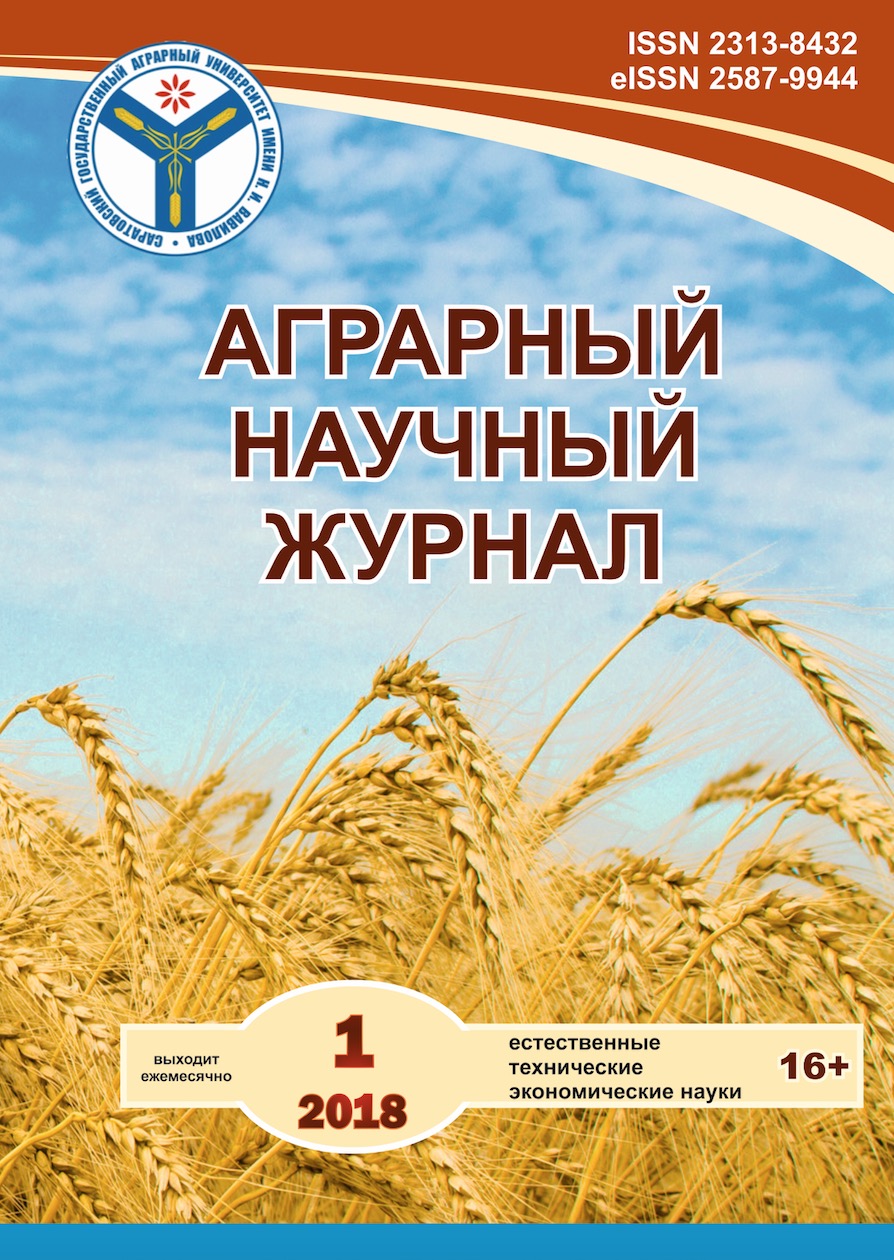THE WATER CONSUMPTION OF WHITE CABBAGE THAT CULTIVATED UNDER DRIP IRRIGATION ON THE CIS-VOLGA DISTRICTS OF SARATOV REGION
DOI:
https://doi.org/10.28983/asj.v0i1.323Keywords:
white cabbage, drip irrigation, irrigation modes, mineral fertilizers dozes, summary water consumption, average daily water consumption, water consumption coefficient, the utilization factor of irrigation waterAbstract
Field research was realized in 2014-2016. The following thesis presents the results of the effect of drip irrigation and calculated doses of mineral fertilizers on the productivity of breeds of white cabbage when grown in the Chernozem steppe of Saratov Cis-Volga region. The field ex-periment was laid down by the method of split plots with three replications on the area of 30 m2. It is was founded that the yield increase of cabbage breed “Amager 611” due to the improved water regime is 4.7–5.7 % compared to the control; due to the improved nutritional regime – 11.1–23.4 %; the yield increase of cabbage hybrid “Kolobok” respectively 10.1 – 19.1 and 11.7% – 31.5%. The water consumption characteristics of crop were defined for the first time for the Saratov Cis-Volga region: total water consumption is 5254.5 – 5712.5 m3/ha, and it in-crease with increasing pre-irrigation soil moisture; a major share in water consumption is irrigation water, which accounts for 52.1-56.3%. The crop consumes the greatest amount of moisture (from 83.8 to 87.6 percent of total water consumption) during the period from the beginning of curling to the technical ripeness of head. Average daily water consumption during the growing season ranges is from 44.53 to 49.03 m3/day. The dependences of the yield of white cabbage that cultivated on the southern chernozem due to joint action of water and fertilizers has the forms: for the «Amager 611» breed Y = –578 + 0.037·DNPK + 0.497·M + 9.901·10-5· DNPK2 – 8.552·10-6· DNPK ·M – 9.244·10-5·M2; for the «Kolobok» hybrid Y = –406 + 0.035· DNPK+ 0.312·M + 1.455·10-4· DNPK2 – 1.361·10-5· DNPK·M – 5.323·10-5·M2 (n of 0.53 and 0.54 respectively). The highest yield of the crop (94.25 t/ha) was obtained by cultivation of the «Amager 611» breed, with the maintenance of the regime of drip irrigation 80% of the field moisture capacity in the 0.3 m layer before the curling of heads and 0.5 m layer after the curling, and the introduction of mineral fertilizers in the dose of N190P80K70.
Downloads
References
2. Бородычев В.В., Кузнецов Ю.В., Дементьев А.В. Водопотребление томатов при капельном орошении // Известия Нижневолжского агроуниверситетского комплекса: Наука и высшее профессиональное образование. – 2007. – № 3. – С. 23–25.
3. Бородычев В.В., Мартынова А.А., Шуравилин А.В. Водопотребление и продуктивность моркови при капельном орошении // Агро ХХI. – 2010. – № 7–9. – С. 34.
4. Доспехов Б.А. Методика полевого опыта. – М.: Колос, 1985. – 416 с.
5. Пронько Н.А., Новикова Ю.А. Продуктивность перца сладкого, вынос и потребление им элементов питания при капельном орошении на темно-каштановых почвах Саратовского Заволжья// Вестник Саратовского госагроуниверситета им. Н.И. Вавилова. – 2010. – № 7. – С. 27–31.
6. Пронько Н.А., Корсак В.В., Фалькович А.С. Орошение в Поволжье: не повторять ошибок // Мелиорация и водное хозяйство. – 2014. – № 4. – С. 16–19.
7. Пронько Н.А., Бикбулатов Е.И., Новикова Ю.А. Способ повышения эффективности капельного полива овощей в Нижнем Поволжье // Мелиорация и водное хозяйство. – 2015. – № 3. – С. 27–30.
8. Пронько Н.А., Бикбулатов Е.И. Повышение эффективности капельного орошения томатов в Саратовском Правобережье // Вестник учебно-методического объединения по образованию в области природообустройства и водопользования. – 2015. – № 7 (7). – С. 163–166.
9. Пути решения проблемы борьбы с деградацией орошаемых земель Саратовской области / Н.А. Пронько [и др.] // Аграрный научный журнал. – 2009. – № 4. – С. 38–45.
10. Ресурсосберегающая технология капельного орошения огурца / А.С. Овчинников [и др.] // Картофель и овощи. – 2009. – № 3. – С. 23.








